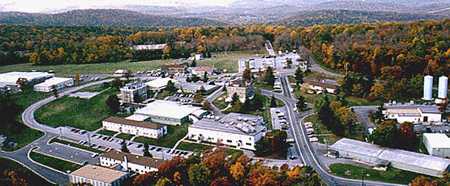The Mount Weather Emergency Operations Center, better known as Mount Weather, is a military underground bunker and missile silo launch facility located in the state of Virginia, United States. It is also one of the Continuity of Government (COG) safety sites in the US, although its exact COG functions are still strictly confidential.
Currently, the facility is managed by the Federal Emergency Management Agency (FEMA) and is also the home of the National Emergency Coordinating Center. The center is in charge of FEMA operations in the aftermath of disasters. It also trains emergency management personnel.
Although FEMA agents handle more localized natural disasters most of the time (such as floods, tornadoes, hurricanes, earthquakes, etc.), the personnel are also trained to handle terrorist attacks.
Mount Weather is a primary relocation site for the highest-ranking military and civilian officials in the event of a national disaster. It is also the location of the FEMA National Radio System (FNARS) control station. FNARS is a high-frequency radio control system that connects the US military and most federal public safety agencies with most of the states. FNARS also gives the president access to the Emergency Alert System, the national warning system in the United States.
The operations center is located in the Blue Ridge Mountains, and access to it is available by way of State Route 601 (which is also known as Blueridge Moutain Road) in Bluemont, Virginia. The facility is situated in Purcellville, Virginia, 82 kilometers (51 miles) west of the capital Washington, D.C.
The above-ground portion of the facility measures at least 434 acres (or 176 hectares), and this scope includes a training area of undetermined size. This part of the facility, completed in 1979, is also known as “Area A”.
The underground portion, on the other hand, is designated as “Area B.” Completed in 1959, this portion measures 56,000 square meters (or 600,000 square feet).
History
The site that became Mount Weather today initially opened as a weather station during the late 1800s. In 1893, the facility was acquired by the National Weather Bureau (later National Weather Service), who used the site to launch weather balloons and to monitor atmospheric research. In the years before the First World War, the bureau conducted a series of kite stations on the site.
In 1936, the government passed Mount Weather to the Bureau of Mines, which started a series of tunneling experiments, less than 300 feet underneath the mountain’s crest, to test the new mining techniques. These experiments also revealed that the mountain had a highly dense and stable rock formation. Based on these evaluations, the Bureau started constructing the facility’s tunnels in 1954. This tunnel construction project, under the code name “Operation High Point,” was completed by the Army Corps of Engineers, and cost around $1 billion. This subterranean facility served as a shelter for government officials in the event of an attack in Washington, DC. It contained offices, a hospital, sleeping quarters, dining and recreation areas, reservoirs of cooling and drinking water, an emergency power plant, and power systems. It even also had a crematorium. While estimates on the capacity may vary, Mount Weather is assumed to hold over 200 residents for a month.
Although FEMA was granted control of the facility in 1979, much of it is still classified. Its above-ground facility functions as a command base for its national all-hazards operations. The Emergency Broadcasting System, in the underground facility, houses the communications networks. The Resource Interruption Monitoring System (RIMS) tracks day-to-day activities and functions of vital national resources, such as oil reserves and manpower systems. The Contingency Impact Analysis Systems (CIAS) develops and directs simulations of emergencies for training and readiness assessment purposes.
The FEMA Mount Weather Assistance Center is the facility’s largest operational center. It conducts FEMA’s aid operations and mostly does the processing of calls concerting aid requests and claims, immediately in the aftermath of a disaster.
Regional FEMA offices are equipped to deal with most emergencies, while the Mount Weather site is most active as a reserve operations post for disaster mitigation. Although FEMA continues its operations on the site, the Continuity of Government emergency plan and facilities at Mount Weather has only been activated in a couple of occasions, so far. The COG measures were put in motion for the first time during the Northeastern power blackout on November 9, 1965. More recently, the second full-scale activation occurred after the September 11, 2001, terrorist attacks.
Did you know?
Located in the Blue Ridge Mountains, near Virginia and west of Washington, D.C., Mount Weather is United States’ government command facility primarily functioning as an emergency center. Let’s find out more interesting facts about Mount Weather.
- Did you know that after the September 11 attacks, most US Congress leaders were evacuated to Mount Weather by helicopter? Mount Weather serves as a major relocation site for US government higher ranking officials in case of emergency. Not just that, the National Gallery of Art had also reported transportation of valuable paintings to Mount Weather via helicopter.

By Alvesgaspar – Own work, CC BY-SA 4.0, https://commons.wikimedia.org/w/index.php?curid=53782413
- There was a video recording through an aerial shot of Mount Weather. It was recorded for a national TV program directed by ABC News producer Bill Lichtenstein. It was a TV segment titled “Nuclear Preparation: Can We Survive, featuring the correspondent Tom Jarriel.
- Mount Weather had been popular for conducting experiments related to the weather. Balloons and kites were sent by scientists aloft to measure air currents and the composition of air in the upper atmosphere. In May 1910, nine-box kites as big as telephone booths, attached by piano wire to ground instruments, set an altitude record of 4 1/2 miles.
In popular culture
Not surprisingly, Mount Weather has been the setting for films, television show episodes, and any other fictional works that have apocalyptic and post-apocalyptic themes. They include The X-Files’ series finale, the 2008 movie The Day The Earth Stood Still, the novel series The 100 as well as its television series adaptation, and many others. It has also been mentioned in several other novels, films, and television shows.

